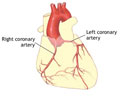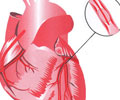 |
Angioplasty is a medical procedure to open narrowed or blocked blood vessels of the heart. These blood vessels are called the coronary arteries. Angioplasty is not considered to be a type of surgery. It is called a percutaneous coronary intervention (PCI). Arteries can become narrowed or blocked by deposits called plaque. Plaque is made up of fat and cholesterol that builds up on the inside of the artery walls. This condition is called atherosclerosis. |
If the blockage is not too severe, an angioplasty procedure can be used to open the artery. Traditional angioplasty involves the use of a balloon catheter -- a small, hollow, flexible tube that has a balloon near the end of it. Before the balloon angioplasty procedure begins, you will be given some pain medicine. Occasionally, blood thinning medicines are also given to prevent formation of a blood clot.
| You will lie down on a padded table. The health care provider will make a small cut on your body, usually near the groin, and insert the catheter into an artery. You will be awake during the procedure. The health care provider will use x-rays to look at your heart and arteries. Dye will be injected into your body to highlight blood flow through the arteries. This helps reveal any blockages in the vessels leading to the heart. The balloon catheter is moved into or near the blockage, and the balloon on the end is blown up (inflated). This opens the blocked vessel and restores proper blood flow to the heart. |  |
You will lie down on a padded table. The health care provider will make a small cut on your body, usually near the groin, and insert the catheter into an artery. You will be awake during the procedure. The health care provider will use x-rays to look at your heart and arteries. Dye will be injected into your body to highlight blood flow through the arteries. This helps reveal any blockages in the vessels leading to the heart. The balloon catheter is moved into or near the blockage, and the balloon on the end is blown up (inflated). This opens the blocked vessel and restores proper blood flow to the heart. In some cases, a device called a stent is also placed at the site of narrowing or blockage in order to keep the artery open. A common type of stent is made of self-expanding, stainless steel mesh. Rarely, a special device with a small, diamond tip is used to drill through the hard plaque and calcium that are causing the blockage. This is called rotational atherectomy.
Why this is done?

